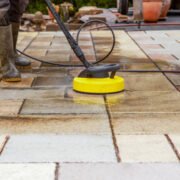Landscape designers need a variety of different tools and equipment to complete their daily tasks. Similar to landscape architects, a landscape designer’s work scope focuses more on residential areas, as opposed to landscape architects who design parks, gardens, resorts, and other outdoor spaces.
Overall, both career specifications will use the same tools, but some of a landscape architect’s tools may be more specialized. Here’s a list of tools essential to both jobs.
Design Tools
Software
Every landscape designer and architect needs a good software program that will allow them to see the finished results of their design projects. The Spruce has ranked SmartDraw as the best overall design software for landscape designers, landscape architects, and even DIY-ers. With landscape design software, you’re able to quickly and easily create designs.
Sketchbook and Other Tools
Even with all of the fancy online design software out there, many designers still go old-school and put their ideas down on a sketchbook. Quick, basic sketches can also be the foundation for online, 3D designs. These can be done in pencil, pen, or even colored pencils.
Landscaping Tools
Box Cutters
Rakes, shovels, and shears are some of the basic landscaping tools, but landscape designers can also benefit from using box cutters. A good, sharp box cutter can cut through landscape fabric.
Hedge Trimmers
Landscape designers should opt for lightweight hedge trimmers. This tool will be held for long periods of time, so a heavier hedge trimmer will cause you to tire quicker and easier.
Lawn Aerator
Aeration is when air is mixed with water and nutrients, and then it is applied to the soil. This helps to eliminate the possibility of compacted soil and helps with the overall health of the ground.
Lawn Mowers and Grass Trimmers
More than likely you’ll be dealing with grass, so you’ll need a way to control the growth of it. As with any type of equipment, and being a professional, you should invest in the best kind— something that will last but also give you the results you desire.
Leaf Blowers
A leaf blower for landscape designers is mainly needed for “touch up” work, rather than actually blowing leaves, though there may be times where a leaf blower is needed in place of a rake. But for touch-ups, this doesn’t have to be the standard size; small, handheld leaf blowers can get the job done just fine.
The Latest Geospatial Technologies
These types of technologies are used to map and analyze the earth.
Remote Sensing
Satellites or flying aircrafts obtain information about the Earth by scanning it from above. They usually carry cameras to take aerial photos. Landscape designers and architects can use this technique to survey different areas of land, collecting information about the physical characteristics.
Geographic Information Systems (GIS)
Geographic information systems are hardware and software systems that gather, analyze, and manage data. It evaluates geographic information and transforms it into digital data, 3D layouts, and maps.
Global Positioning Systems (GPS) and Internet Mapping Technologies
GPS isn’t just for finding your way to or through a particular location. Landscape designers and other geography-related careers also use this tool to map out exact geographical locations. They can also use similar internet maps like Google Earth to view the characteristics of a particular area.
Pickup Trucks
Landscape designers need a way to transport all of their tools and equipment to and from the work site. Many use their own vehicles or company trucks, but if you’re in business for yourself, you have the option to rent a truck for six months or longer, depending on how long it will take to complete your project. You can also rent multiple trucks at a time.
Landscape designers use a variety of tools and equipment. In any type of business, it’s important to have the best of the best in order to accomplish all of the necessary tasks associated with your job.












